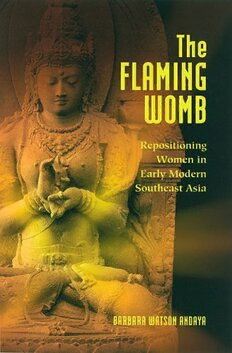
The Flaming Womb: Repositioning Women in Early Modern Southeast Asia PDF
353 Pages·2006·3.15 MB·English
Most books are stored in the elastic cloud where traffic is expensive. For this reason, we have a limit on daily download.
Preview The Flaming Womb: Repositioning Women in Early Modern Southeast Asia
Description:
"The Princess of the Flaming Womb," the Javanese legend that introduces this pioneering study, symbolizes the many ambiguities attached to femaleness in Southeast Asian societies. Yet despite these ambiguities, the relatively egalitarian nature of male-female relations in Southeast Asia is central to arguments claiming a coherent identity for the region. This challenging work by senior scholar Barbara Watson Andaya considers such contradictions while offering a thought-provoking view of Southeast Asian history that focuses on women’s roles and perceptions. Andaya explores the broad themes of the early modern era (1500–1800)—the introduction of new religions, major economic shifts, changing patterns of state control, the impact of elite lifestyles and behaviors—drawing on an extraordinary range of sources and citing numerous examples from Thai, Vietnamese, Burmese, Philippine, and Malay societies. In the process, she provides a timely and innovative model for putting women back into world history.Andaya approaches the problematic issue of "Southeast Asia" by considering ways in which topography helped describe a geo-cultural zone and contributed to regional distinctiveness in gender construction. She examines the degree to which world religions have been instrumental in (re)constructing conceptions of gender—an issue especially pertinent to Southeast Asian societies because of the leading role so often played by women in indigenous ritual. She also considers the effects of the expansion of long-distance trade, the incorporation of the region into a global trading network, the beginnings of cash-cropping and wage labor, and the increase in slavery on the position of women. Later chapters draw inspiration from recent work that stresses the need for historical contextualization of interactions between women and "the state" and gender constructs in elite households inflected by class priorities. Throughout, her creative approach to familiar sources offers surprising results and, while always alert to the difficulties of generalization, affirms the existence of a Southeast Asia where the history of women can be legitimately investigated.Erudite, nuanced, and accessible, The Flaming Womb makes a major contribution to a Southeast Asia history that is both regional and global in content and perspective. It offers a new view of the region that will appeal to students and specialists in a variety of disciplines.
See more
The list of books you might like
Most books are stored in the elastic cloud where traffic is expensive. For this reason, we have a limit on daily download.
